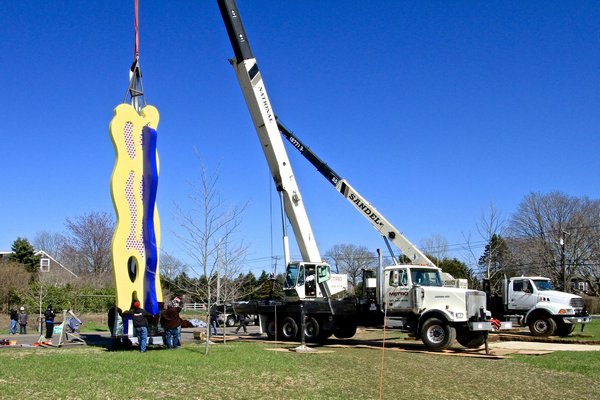
They said it would take just 10 minutes.
Terrie Sultan knew better than that.
She stood on the expansive front lawn of the Parrish Art Museum in Water Mill on Thursday, April 17, at 11 a.m. and tilted her head back. Her sharp eyes examined the handful of installers affixing a finishing trim onto artist Roy Lichtenstein’s soaring aluminum sculpture “Tokyo Brushstroke I,” while its counterpart, “Tokyo Brushstroke II,” lay in the grass on its side, patiently awaiting its moment.
“We’re actually just getting ready to tilt up the second piece. I don’t know how long it will take from now,” the museum director said. “They say 10 minutes. My guess is an hour. It’s slow going. You have to be very careful. This is not an easy thing to do.”
On Wednesday, April 16, at 7 a.m., close to 20 crew members descended upon the Parrish grounds with two cranes and three flatbed trucks transporting a combined 17,000 pounds of painted and fabricated metal that, once constructed, would stand taller than the 32-foot-high Parrish itself, and mark the museum’s entrance on Montauk Highway with a burst of energy and primary color—a foil to the building’s strict architecture and muted tones.
The pair, “Tokyo Brushstroke I & II,” is the first-ever long-term outdoor installation at the museum’s new Herzog & de Meuron-designed building, thanks to a loan from the Roy Lichtenstein Foundation and collectors Glenn and Amanda Fuhrman.
“Glenn felt, like all of us, that if you were going to install a major sculpture in the 14 acres of this museum, who better than Roy Lichtenstein?” Ms. Sultan said. “And we all agreed. Roy is one of the most important, key artists of our generation and added tremendous presence and meaning to the creative community on the East End.”
Mr. Lichtenstein—who lived in Southampton with his wife, Dorothy, until his death in 1997—created his first brushstroke piece in the fall of 1965: a flat painting inspired by a comic strip panel, according to Jack Cowart, executive director of the Roy Lichtenstein Foundation. With the advent of public sculpture in the 1960s, the pop artist shifted this particular brushstroke interest into the third dimension with scalable art and fabrications. It gave him a sense of freedom, Mr. Cowart said, while evoking joy and optimism.
The piece—a brushstroke, a gesture, a building block of any painting—is “a symbol of something that isn’t,” Mr. Lichtenstein once noted, “and that is part of the irony I’m interested in.”
“I can’t think of any other artist who has done painted sculptures of liquid brushstrokes. It’s such a loony idea that would only appeal to Roy,” Mr. Cowart said, ducking out of Thursday’s chilly wind and into a sunny patch next to the museum. “There’s an absurdity in it. The more you think about it, the goofier it gets. He’s not trying to say that this is like the Washington Monument, a very serious memorial piece. It’s about the joy of painting, or looking at it, done in seven tons of metal.”
Even though “Tokyo Brushstroke I & II” are two of the largest in Mr. Lichtenstein’s brushstroke series, they started just like the rest, as drawings, before transitioning into cut-paper collages and, finally, two maquettes—31 and 21 inches, respectively—that were projected and redrawn full-scale onto foam core. From those, the fabricator cut the aluminum into a “balletic composition of form and color,” Mr. Cowart said.
The first pair, constructed in 1994—just three years before Mr. Lichtenstein’s death on September 29, 1997—are installed in an urban, dramatically vertical Tokyo setting. It is a complete departure from the Parrish’s horizontal setting. This version was cut from an “artist proof,” or a reproduction, in 2009, Ms. Sultan explained, and has never been installed anywhere else.
“I’ve never seen the ‘Brushstrokes’ upright. I’ve seen them in fabrication,” Mr. Cowart said. “I couldn’t ask for a better setting and a long view, a big open field. It’s very fancy. I love the way the aluminum of the roof plays against the aluminum of that piece.”
He gestured to “Tokyo Brushstroke I” and continued, “I mean, it was strictly dumb luck. I hadn’t thought of it, at all, being connected to this building.”
The installation has been a year in the making, Ms. Sultan explained, following countless renderings, models and consultations on site. The director declined to disclose the project’s cost, only to say that it is a group effort and a “tremendous commitment on the side of the collectors and the foundation to help us make this doable.”
Day one proved to be the most challenging, according to Mitch Didier, president of Marshall Fine Arts in Deer Park, which has been moving and storing art for Mr. Lichtenstein since 1972. It involved a precise strategy called “tripping,” where a pair of cranes worked in tandem to join the two pieces of “Tokyo Brushstroke I” into a 33-foot-high sculpture weighing more than six tons. It is bolted down into a 4-foot-thick, 40,0000-pound cement slab that was poured into the Parrish’s front lawn.
“This is such a precisely and beautifully fabricated sculpture, and now the monumentality of it,” Mr. Didier said, looking at the nearly completed piece. “Once it’s vertical, it’s so far beyond human scale and has such a ‘wow’ factor. Once we get the other one over by the road, it announces to the world that the Parrish Art Museum has arrived.”
Finally, just a few minutes past noon—as Ms. Sultan had predicted—the crane lifted the 19-foot-high, two-ton “Tokyo Brushstroke II” and swung it over to its respective cement slab, carefully dodging its colorful counterpart with the help of six men.
An enthusiastic noise escaped from Ms. Sultan as she shot the crane operator a double thumbs up.
“We love it!” she shouted, Mr. Cowart standing next to her. “That is really magnificent.”
They shook their heads disbelievingly and shared a smile before returning their attention to the two pieces.
Roy Lichtenstein is here.